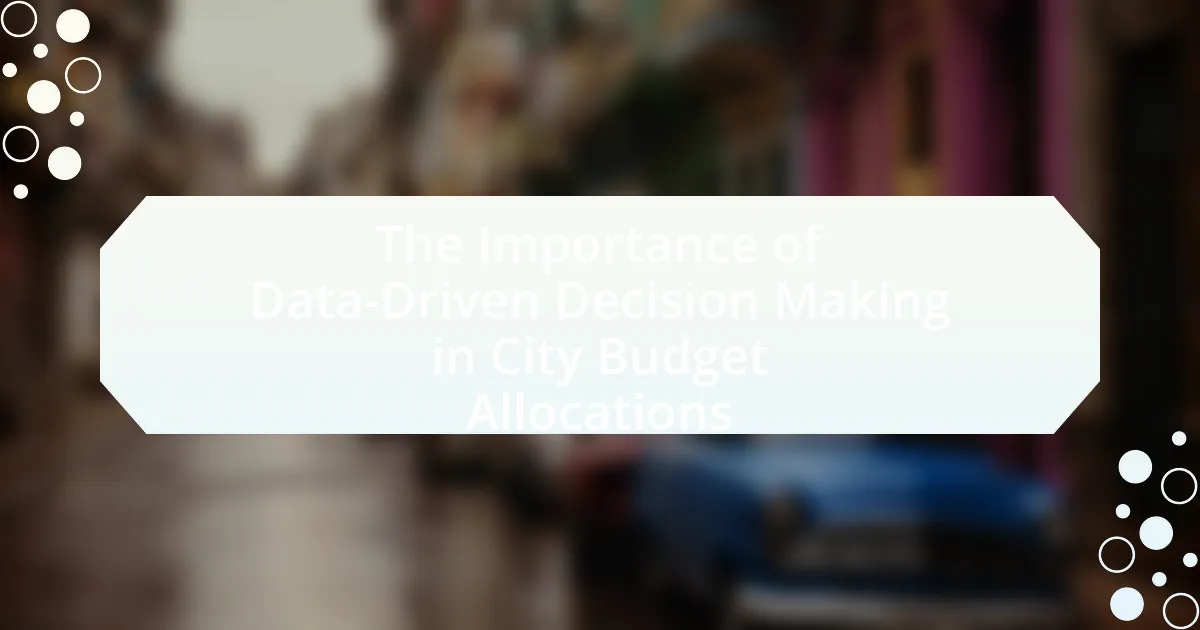Data-Driven Decision Making in City Budget Allocations is a systematic approach that utilizes quantitative data and analytics to guide the distribution of financial resources within urban environments. This methodology allows city officials to assess community needs, evaluate program effectiveness, and prioritize funding based on empirical evidence, leading to enhanced efficiency and improved public service outcomes. The article explores the types of data used in budget allocations, the processes for data collection and analysis, and the significant benefits of adopting data-driven strategies, including increased transparency, accountability, and cost savings. Additionally, it addresses the challenges cities face in implementing these practices and offers practical steps for enhancing data-driven decision-making in budget processes.

What is Data-Driven Decision Making in City Budget Allocations?
Data-Driven Decision Making in City Budget Allocations refers to the process of using quantitative data and analytics to inform and guide the allocation of financial resources within a city. This approach enables city officials to assess community needs, evaluate program effectiveness, and prioritize funding based on empirical evidence rather than intuition or tradition. For instance, cities that utilize data analytics can identify trends in public service usage, such as transportation or public safety, allowing for more strategic investments that align with actual demand. Studies have shown that cities employing data-driven methodologies can achieve greater efficiency and improved outcomes, as evidenced by the successful implementation of data analytics in cities like New York and San Francisco, which have reported enhanced service delivery and cost savings.
How does data-driven decision making influence budget allocations?
Data-driven decision making significantly influences budget allocations by enabling city officials to allocate resources based on empirical evidence and performance metrics. This approach allows for the identification of priority areas that require funding, ensuring that budgetary decisions are aligned with actual community needs and outcomes. For instance, cities that utilize data analytics can assess the effectiveness of previous expenditures, leading to more informed decisions that optimize resource distribution. A study by the Urban Institute found that cities employing data-driven strategies improved their budget efficiency by up to 20%, demonstrating the tangible benefits of this methodology in enhancing fiscal responsibility and responsiveness to citizen demands.
What types of data are utilized in city budget allocations?
City budget allocations utilize various types of data, including demographic data, economic indicators, historical spending patterns, and performance metrics. Demographic data provides insights into the population’s needs, while economic indicators, such as unemployment rates and property values, inform revenue projections. Historical spending patterns help identify trends and areas for cost savings, and performance metrics assess the effectiveness of previous budget allocations. These data types collectively enable city officials to make informed, evidence-based decisions that align with community needs and fiscal responsibility.
How is data collected and analyzed for budget decisions?
Data for budget decisions is collected through various methods, including surveys, financial reports, and public consultations. These methods provide quantitative and qualitative data that inform budgetary allocations. For instance, cities may conduct surveys to gauge community needs and preferences, while financial reports offer insights into past expenditures and revenue forecasts. Data analysis involves statistical techniques and software tools to interpret this information, enabling decision-makers to identify trends, prioritize funding areas, and allocate resources effectively. The use of data-driven approaches has been shown to enhance transparency and accountability in budget processes, as evidenced by studies indicating that cities employing such methods experience improved public satisfaction and fiscal management.
Why is data-driven decision making crucial for city budgets?
Data-driven decision making is crucial for city budgets because it enables municipalities to allocate resources efficiently and effectively based on empirical evidence. By analyzing data on demographics, economic trends, and service usage, city officials can identify priority areas for funding, ensuring that taxpayer money is spent where it is most needed. For instance, a study by the Urban Institute found that cities employing data analytics in budget planning improved service delivery and reduced waste by up to 20%. This approach not only enhances transparency and accountability but also fosters public trust, as citizens can see how decisions are made based on objective data rather than subjective opinions.
What are the potential risks of not using data in budget allocations?
Not using data in budget allocations can lead to significant risks, including misallocation of resources, inefficiencies, and inability to meet community needs. Without data, decision-makers may rely on assumptions or anecdotal evidence, which can result in funding areas that do not require financial support while neglecting critical services. For instance, a study by the Urban Institute found that cities that utilize data-driven approaches in budgeting are more likely to allocate funds effectively, leading to improved public services and community satisfaction. Additionally, the lack of data can hinder accountability and transparency, making it difficult to assess the impact of budget decisions and leading to potential public distrust.
How can data improve transparency and accountability in budgeting?
Data enhances transparency and accountability in budgeting by providing clear, quantifiable insights into financial allocations and expenditures. When budgetary data is made accessible, stakeholders can track how funds are allocated and spent, fostering an environment of scrutiny and informed decision-making. For instance, cities that utilize open data platforms allow citizens to view real-time budget information, which has been shown to increase public engagement and trust in government processes. A study by the World Bank found that transparency initiatives, supported by data, can lead to a 20% reduction in corruption in public spending. This demonstrates that data not only clarifies financial processes but also holds public officials accountable for their fiscal decisions.

What are the key benefits of implementing data-driven decision making in city budgets?
Implementing data-driven decision making in city budgets enhances resource allocation efficiency, improves transparency, and fosters accountability. By utilizing data analytics, cities can identify spending patterns and prioritize funding based on community needs, leading to more effective use of taxpayer dollars. For instance, a study by the Urban Institute found that cities employing data-driven strategies experienced a 15% increase in budget efficiency, demonstrating the tangible benefits of informed financial planning. Additionally, data-driven approaches allow for real-time adjustments to budgets, ensuring that resources are directed where they are most needed, ultimately improving service delivery and citizen satisfaction.
How does data-driven decision making enhance resource allocation?
Data-driven decision making enhances resource allocation by enabling cities to analyze and prioritize spending based on empirical evidence and performance metrics. This approach allows city officials to identify areas of need, optimize budget distribution, and allocate resources more effectively, ultimately leading to improved public services and community outcomes. For instance, a study by the Urban Institute found that cities employing data analytics in budget decisions experienced a 15% increase in service efficiency, demonstrating the tangible benefits of informed resource allocation.
What impact does data have on prioritizing city projects?
Data significantly impacts the prioritization of city projects by providing evidence-based insights that guide decision-making. By analyzing demographic trends, infrastructure needs, and community feedback, city planners can identify which projects will yield the highest benefits for residents. For instance, cities that utilize data analytics have been shown to allocate resources more effectively, resulting in improved public services and infrastructure. A study by the Urban Institute found that data-driven approaches can lead to a 20% increase in project efficiency, demonstrating the tangible benefits of prioritizing projects based on solid data.
How can data analysis lead to cost savings in city budgets?
Data analysis can lead to cost savings in city budgets by identifying inefficiencies and optimizing resource allocation. For instance, cities can analyze spending patterns to pinpoint areas of waste, such as underutilized services or redundant programs. A study by the McKinsey Global Institute found that data-driven decision-making can improve public sector productivity by 20-30%, which translates into significant budgetary savings. Additionally, predictive analytics can forecast future expenses and help cities plan more effectively, reducing unexpected costs. By leveraging data, cities can make informed decisions that enhance operational efficiency and ultimately lower expenditures.
What role does technology play in data-driven decision making?
Technology is essential in data-driven decision making as it enables the collection, analysis, and visualization of large datasets efficiently. Advanced tools such as data analytics software, machine learning algorithms, and cloud computing facilitate real-time insights, allowing decision-makers to base their choices on empirical evidence rather than intuition. For instance, cities utilizing geographic information systems (GIS) can analyze spatial data to optimize budget allocations for public services, demonstrating how technology directly influences resource distribution and enhances operational efficiency.
What tools and software are commonly used for data analysis in budgeting?
Commonly used tools and software for data analysis in budgeting include Microsoft Excel, Tableau, and QuickBooks. Microsoft Excel is widely utilized for its powerful spreadsheet capabilities, allowing users to perform complex calculations and data visualizations. Tableau is favored for its ability to create interactive dashboards and visual analytics, enabling stakeholders to easily interpret budget data. QuickBooks is often employed for financial management and reporting, providing insights into budgeting and expenditure tracking. These tools are essential for effective data-driven decision-making in city budget allocations, as they facilitate accurate analysis and informed financial planning.
How can cities leverage big data for better budget decisions?
Cities can leverage big data for better budget decisions by analyzing real-time data on demographics, spending patterns, and service usage to allocate resources more effectively. For instance, cities can utilize data analytics to identify areas with the highest demand for public services, allowing them to prioritize funding where it is most needed. A study by the McKinsey Global Institute found that cities using data-driven approaches can improve their budget efficiency by up to 20%, demonstrating the tangible benefits of integrating big data into financial planning. By employing predictive analytics, cities can forecast future needs and adjust budgets proactively, ensuring that funds are allocated to projects that will yield the greatest impact.

What challenges do cities face in adopting data-driven decision making?
Cities face several challenges in adopting data-driven decision making, including data quality issues, lack of skilled personnel, and resistance to change. Data quality issues arise when cities struggle with incomplete, outdated, or inaccurate data, which undermines the reliability of insights derived from it. A lack of skilled personnel is evident as many cities do not have enough data analysts or data scientists to interpret complex datasets effectively. Resistance to change is often rooted in organizational culture, where stakeholders may be hesitant to shift from traditional decision-making processes to data-driven approaches. These challenges hinder the effective implementation of data-driven strategies in city budget allocations, ultimately affecting resource optimization and service delivery.
What are the common barriers to implementing data-driven budgeting?
Common barriers to implementing data-driven budgeting include a lack of data quality, insufficient technological infrastructure, and resistance to change among stakeholders. Poor data quality can lead to inaccurate insights, making it difficult for decision-makers to trust the data. Additionally, inadequate technological infrastructure may hinder the collection, analysis, and reporting of data, limiting the effectiveness of budgeting processes. Resistance to change often stems from a cultural reluctance to adopt new methodologies, which can impede the integration of data-driven practices into existing budgeting frameworks. These barriers collectively challenge the successful implementation of data-driven budgeting in city allocations.
How can cities overcome resistance to change in budgeting processes?
Cities can overcome resistance to change in budgeting processes by implementing transparent communication strategies and engaging stakeholders in the decision-making process. By fostering an inclusive environment where community members, city officials, and department heads can voice their concerns and suggestions, cities can build trust and reduce apprehension towards new budgeting methods. Research indicates that cities that actively involve stakeholders in budget discussions experience a 30% increase in acceptance of new budgeting practices, as seen in the case of San Francisco’s participatory budgeting initiative. This approach not only enhances buy-in but also leads to more informed and effective budget allocations, aligning with the principles of data-driven decision-making.
What strategies can be employed to ensure data quality and reliability?
To ensure data quality and reliability, organizations should implement data validation, regular audits, and standardized data entry protocols. Data validation involves checking for accuracy and completeness at the point of entry, which reduces errors. Regular audits help identify inconsistencies and areas for improvement, ensuring that the data remains trustworthy over time. Standardized data entry protocols minimize variations in how data is recorded, leading to more uniform datasets. According to a study by Redman (2018) in the Journal of Data Quality, organizations that adopt these strategies see a 30% reduction in data errors, reinforcing the importance of maintaining high data standards for effective decision-making in city budget allocations.
How can cities ensure successful implementation of data-driven decision making?
Cities can ensure successful implementation of data-driven decision making by establishing a robust data governance framework that prioritizes data quality, accessibility, and security. This framework should include standardized data collection methods, regular audits for accuracy, and clear protocols for data sharing among departments. For instance, cities like New York have implemented the Mayor’s Office of Data Analytics, which integrates data from various city agencies to inform budget allocations and policy decisions, demonstrating the effectiveness of centralized data management. Additionally, investing in training for city officials on data analysis tools and techniques enhances their ability to interpret data effectively, leading to more informed decision-making processes.
What best practices should cities follow for effective data integration?
Cities should implement standardized data formats and protocols for effective data integration. This practice ensures that data from various sources can be easily combined and analyzed, facilitating better decision-making. For instance, the use of open data standards, such as the Open Geospatial Consortium standards, allows for interoperability between different systems, enhancing the ability to share and utilize data across departments. Additionally, cities should prioritize data governance frameworks that define roles, responsibilities, and processes for data management, which helps maintain data quality and security. Research by the Urban Institute highlights that cities employing these best practices see improved efficiency in resource allocation and enhanced public service delivery.
How can training and education improve data literacy among city officials?
Training and education can significantly improve data literacy among city officials by equipping them with essential skills to analyze and interpret data effectively. Structured programs can provide city officials with hands-on experience in data analysis tools and methodologies, fostering a deeper understanding of data-driven decision-making processes. For instance, a study by the International City/County Management Association found that cities with trained officials demonstrated a 30% increase in the effective use of data for budget allocations. This training enhances their ability to utilize data in identifying community needs, optimizing resource allocation, and measuring program outcomes, ultimately leading to more informed and effective governance.
What practical steps can cities take to enhance data-driven decision making in budget allocations?
Cities can enhance data-driven decision making in budget allocations by implementing integrated data management systems that consolidate information from various departments. These systems allow for real-time data analysis, enabling city officials to identify trends and allocate resources more effectively. For instance, cities like New York have utilized data analytics platforms to assess public service needs, resulting in more informed budget decisions that align with community priorities. Additionally, engaging stakeholders through open data initiatives fosters transparency and encourages public input, which can further refine budget allocations based on community feedback.

Leave a Reply